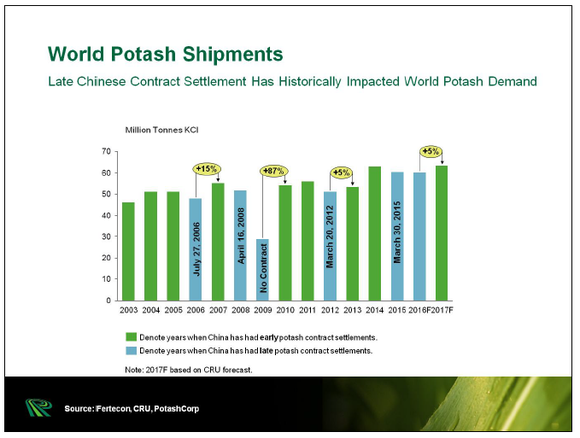
The potash market has been under pressure since the breakup of the international cartel, but prices may have finally reached their nadir. Image source: Getty Images.
This could be the signal the crop nutrition producers have been waiting for to indicate the market is about to make a U-turn. No, not the merger of equals between PotashCorp (NYSE: POT) and Agrium (NYSE: AGU) that was confirmed this week, but rather the supply deal signed with both China and India by the world’s largest potash producer, Uralkali.
The straw that stirs the drink
The potash market has been waiting for China to ink deals with potash producers. Usually signed early in the year, or late spring the latest, China held off until the end of July before coming to terms with Belaruskali, the one-time partner of Uralkali in the Belarusian Potash Corp cartel. And that only came about after India had signed one with BPC at prices some 30% below the prior year’s contract.
Because China is the world’s largest consumer of potash (and just about every other commodity), it typically gets the best pricing . Where Belaruskali’s contract with India saw it accept $ 227 per metric ton, the one with China was even lower, at $ 219 per metric ton.
The potash market was thrown into turmoil in 2013 when Uralkali broke away from BPC because it wanted to gain market share by selling all of its production into the market. Beforehand, the cartel typically withheld some of the inventory from sale in a bid to keep prices elevated.
Yet potash that once had sold for around $ 900 per metric ton during the commodities boom was cut in half or more, and Uralkali, as the low-cost production leader, saw an opportunity to take more share. The cartel’s breakup, however, caused pricing to go into a tailspin, immediately falling to $ 325 per metric ton. With plentiful supplies, China saw no need to sign a new agreement as it drew down its inventory and allowed competitive pressures to drive prices even lower.
Although there was the possibility China might not sign a contract at all this year, PotashCorp was upbeat that the bottom had been reached nevertheless, and said it expected prices to rise next year. It pointed out that years in which China failed to sign a contract or was late doing so — few and far between though they were — the following year always saw prices increase.

Image source: PotashCorp.
Low-price environment
Certainly Belaruskali’s contract with India first, then China was more than what many analysts thought might be the possible, as they suggested a price of $ 200 per metric ton or less would be not unreasonable. PotashCorp was reporting global average prices of just $ 178 per metric ton while Agrium and Mosaic (NYSE: MOS) , PotashCorp’s partners in the North American potash marketing group Canpotex, were reporting prices of $ 199 and $ 207 per metric ton, respectively.
These new contracts signed with Uralkali are significant, not least because the crop nutrient producer had scoffed at the price Belaruskali agreed to saying they were too low. While Uralkali didn’t say what price it got — just that they were in-line with the market — the length of the Indian contract indicates the demand drought may be over.
Uralkali will deliver 600,000 metric tons of potash to various Chinese customers through January and will sell 650,000 metric tons to Indian Potash through July 2017.
The growing season in these countries is just getting underway, and having drawn down their inventories, they need to restock. Belaruskali’s China contract was for delivering 1.3 million metric tons by the end of the year while Israel Chemicals agreed to supply China with 700,000 metric tons in 2016.
Canpotex is the last remaining major supplier yet to sign a contract with either China or India, though it’s said to be in negotiations. Having waited so long, it may not get terms as good as those offered to the others, but with demand looking like it’s growing once again, PotashCorp’s prediction of improved pricing in 2017 may yet come true.
A secret billion-dollar stock opportunity
The world’s biggest tech company forgot to show you something, but a few Wall Street analysts and the Fool didn’t miss a beat: There’s a small company that’s powering their brand-new gadgets and the coming revolution in technology. And we think its stock price has nearly unlimited room to run for early in-the-know investors! To be one of them, just click here .
Rich Duprey has no position in any stocks mentioned. The Motley Fool has no position in any of the stocks mentioned. Try any of our Foolish newsletter services free for 30 days . We Fools may not all hold the same opinions, but we all believe that considering a diverse range of insights makes us better investors. The Motley Fool has a disclosure policy .
The views and opinions expressed herein are the views and opinions of the author and do not necessarily reflect those of Nasdaq, Inc.
Plantations International